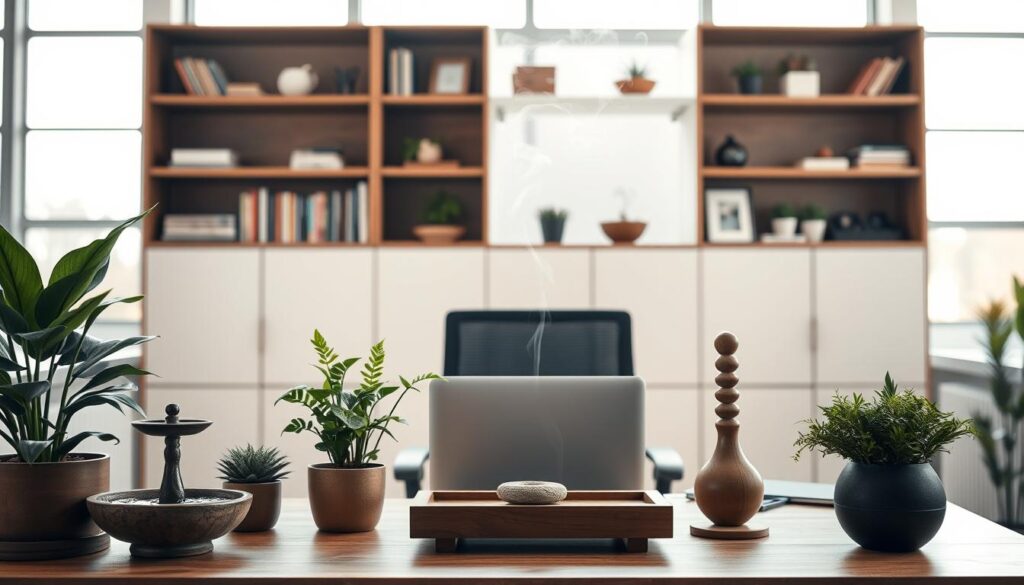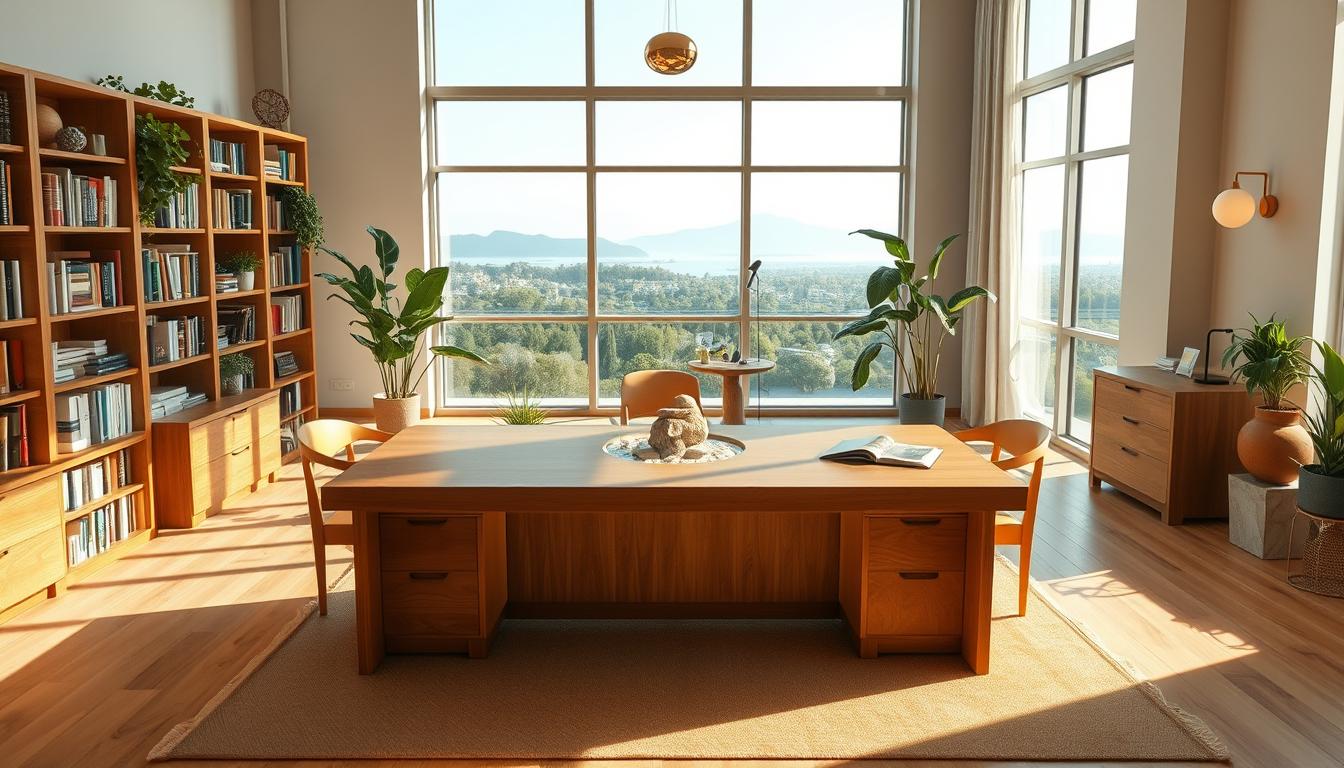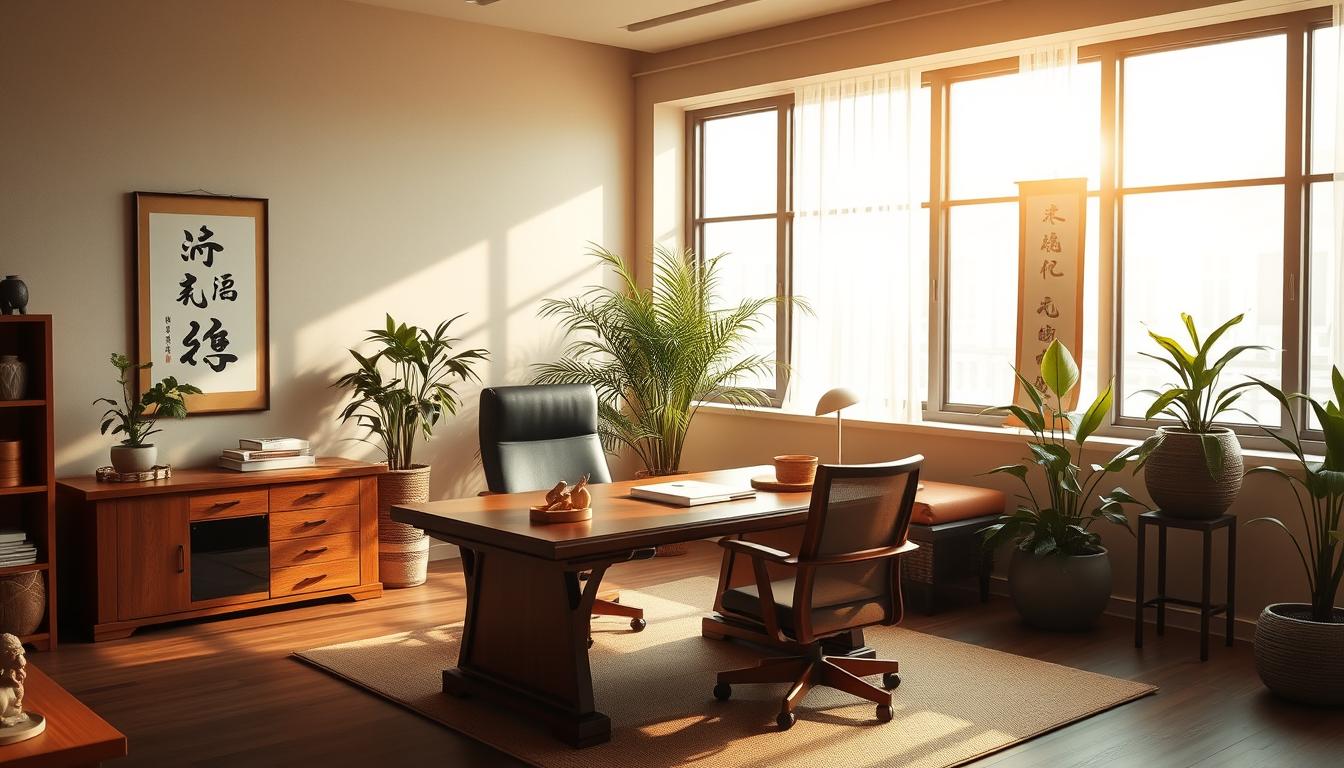Transforming your office with feng shui lighting can make your workspace feel better and boost your productivity. Lighting isn’t just for seeing where you are going; it’s key for a good energy flow and setting a peaceful mood. Bright lights spark positivity in a room, helping good energy move freely, while too much or too little light can mess with the vibe.
Knowing how to use natural light, picking the right bulbs, and matching colors can create a balanced office. This article will show you how to make your office’s lighting better. By doing so, your work area will become more lively and comforting.
The Importance of Feng Shui in Office Lighting
Effective lighting is key to creating a peaceful yet productive workplace. It must follow feng shui rules to bring harmony. By using the right lights, we can boost happiness and work better.
Understanding the Concept of Chi
Chi is a vital energy found in everything around us. Feng Shui sees its flow as crucial. Good lighting increases focus, creativity, and comfort, enhancing chi.
Using various light sources wisely helps energize the office. Remember, bright lights boost chi, but too harsh lighting blocks it.
Connecting Lighting with Energy Flow
Light dramatically affects energy flow in office spaces. Natural light is best, improving mood and connecting us outdoors. Artificial lights are necessary when natural light isn’t enough.
For a calm ambiance, choose soft lights. Bright lights are best for task-focused spots. Colors matter too; warm hues add cozy vibes, cool ones aid focus.
Adjustable lights help fight dull energy in dark spots. This enhances your office’s Feng Shui.
Natural Light: Harnessing Daylight in Your Workspace
Natural light is key to a better office vibe and work output. It boosts mood and productivity. Getting enough daylight affects energy and focus positively.
Benefits of Natural Light on Productivity
Natural light does wonders for work performance. It lifts spirits and improves health, leading to more productivity. Daylight boosts serotonin, which improves focus and energy. A sunny office also sparks creativity and drive.
Strategies for Maximizing Natural Light
To make the most of natural light, try these tips:
- Keep windows clear to let in lots of sunlight.
- Use sheer curtains to soften bright sunlight while keeping the room bright.
- Add plants to your workspace for better air and more vitality.
- Position plants well to boost the office’s energy.
- Use full-spectrum lighting when there’s not enough sunlight. It mimics natural light.
- Place table lamps in a triangle setup for a good energy flow.
- Choose cool-toned lighting (around 5000k) in busy areas to increase alertness and productivity.
Choosing the Right Light Bulbs for Your Office
Picking the right light bulbs changes how productive and comfy your office feels. It’s key to know the effects of warm and cool light. Full-spectrum bulbs give off a blend perfect for work and looks.
Warm-Toned vs. Cool-Toned Lighting
Warm light, under 3000K, makes spaces cozy, perfect for relaxing. Cool light, between 4000K to 5000K, keeps you sharp and focused. This light is best for work that needs lots of attention.
Using both light types in your office meets different needs. Here’s how:
- Cool light works great in work areas to keep you on point.
- Warm light in chill or meeting spots makes things mellow.
- Stick to one bulb type per fixture to keep the mood right.
The Impact of Full-Spectrum Bulbs
Full-spectrum bulbs are like daylight, keeping you bright and peppy. They’re perfect for places where you need to see clearly. They mix the best of natural and artificial light, boosting your space’s vibe.
Choosing stylish bulbs like Plumen adds brightness without losing style. Mixing light types—ambient, task, and accent—according to Feng Shui, brings balance. Avoid lights that are too harsh or blink a lot, as they can mess with the energy flow.
Feng Shui Office Lighting: Balancing Light Sources
Making your office light just right boosts productivity and feels good. The right mix of general and focused lighting follows Feng Shui. This means better energy flow or “chi”. So, layering light can make your workspace both welcoming and full of energy.
The Role of Ambient and Task Lighting
Ambient lighting gives off a soft, overall light, making the office usable. Task lighting adds focus to places where you work. Together, they get rid of shadows and let you see clearly without strain.
For good vibes, don’t put harsh lights right above you. Instead, mix different lights like floor and table lamps, plus fairy lights, for full coverage. Round lights work best for easier energy flow than sharp ones.
Layering Different Types of Lighting for Harmony
Mixing light types makes the office welcoming. Use warm lights for chill zones and cooler lights for busy spots. Aim for both direct and indirect lighting to soften the place.
Add uplighting to make low ceilings seem higher and move energy better. Mirrors can spread light and make rooms look bigger. This mix of lights lines up with Feng Shui, making your office in harmony.
Incorporating Color into Your Office Lighting
Color psychology in lighting is a key player in setting your office’s mood and energy. Different colors trigger different feelings, helping promote work or relaxation. By choosing colors wisely, you can make a space that helps everyone focus and feel peaceful.
The Psychological Effects of Different Colors
Colors can really change the way we feel and act in a space. Picking the right colors for your office can boost productivity and create a welcoming vibe. Here are some colors to think about:
- White: Stands for clarity and focus, boosting productivity and mental sharpness.
- Gray: Mixes metal and earth qualities, bringing clear thoughts in light shades and a grounding feeling in darker ones.
- Green: Means growth and life, linked to creativity and new ideas.
- Brown: Tied to the earth element, this color offers stability, perfect for calming office spaces.
- Black: Brings a sense of wisdom and depth, signaling career goals and is great for accent pieces.
Colors that Enhance Focus and Calmness
To create a welcoming and effective work environment, mix colors that are both energizing and relaxing. The best colors for focus include:
- Reds: Show happiness and wealth. They work well as accent colors to bring energy to your office.
- Blues: Bring in the water element, boosting work efficiency and providing peace.
- Greens: Offer a sense of peace while encouraging growth and new beginnings.
- Earth Tones: Using greens, yellows, and browns makes for a calming, nature-like setting.
Using Reflective Surfaces in Your Office Design
Using reflective surfaces in your office helps with feng shui principles. Mirrors are key in boosting space and energy flow. They create a peaceful, productive atmosphere. Placing these elements wisely changes your workspace for the better.
Benefits of Mirrors in Feng Shui
Mirrors are strong tools in feng shui. They make rooms brighter and seem bigger. This illusion of space is vital for good energy, or Chi, flow. Small decor and mirrors together adjust this energy well.
- Mirrors bring in wood energy by reflecting natural scenes like trees.
- They let you see more from your desk, fixing your office layout.
- Using mirrors thoughtfully helps attract the five key elements of feng shui design.
Creating Space and Light with Reflective Materials
Reflective materials boost light and create peace in your office. Mirrors light up spaces and spread natural light, making everything lively. Adding small fountains and glass dividers uses the “Water” element for better focus and calm.
Such materials make your office balanced and pleasant. This way, you get a workspace that’s bright, welcoming, and boosts productivity. It’s all about harmony.
Avoiding Harsh Lighting Conditions
To make a comfortable work space, look at your lighting. Harsh lights, like the common fluorescent ones, can lower morale and productivity. Knowing how these lights hurt the work area helps improve employee happiness. Use softer light sources to make a welcoming space.
Understanding the Negative Impact of Fluorescent Lights
Fluorescent lights cause harsh shadows and flicker, leading to discomfort. This can make people feel headaches, stress, and bring a negative vibe to the office. Swap out fluorescent lights for warmer bulbs like LED or incandescent to make things cozier.
How to Soften Overhead Lighting
To lessen harsh lighting, mix different light sources. Use floor lamps, reading lamps, and wall sconces together. This mix adds warmth and balances the light in the room. Using soft, diffused lighting with natural-colored shades helps keep the mood calm.
- Use rounded light fixtures to soften sharp corners and promote positive energy flow.
- Install dimmers to adjust lighting levels, creating a calm and non-overwhelming environment.
- Avoid multi-faceted fixtures that can lead to uneven lighting and harsh shadows.
- Position task lighting carefully to focus on work areas without causing glare on screens.
- Utilize solar shades or blinds to manage direct sunlight and prevent glare.
Adjustable Lighting: Flexibility in Your Workspace
Making your workspace productive means having the right light. Adjustable lighting lets you change the brightness and feel of your space. This makes it easier to focus and stay comfortable. With the best setup, your workspace will help you do better and feel good too.
The Use of Desk Lamps for Focused Work
Desk lamps are great for lighting up your work area just right. They come with parts that move, so you can shine the light exactly where you need it. This reduces screen glare and makes work easier on your eyes. Most have a dimmer, so you can make the light perfect for any time or task.
Smart Lighting Solutions for Different Tasks
Smart lighting takes making your workspace better up a notch. It offers LED bulbs you can adjust for brightness and color, fitting your needs or mood. Some even run on USB, giving you more options for where to use them. These lights set the mood for work, relax time, or group projects. They also protect your eyes from too much blue light.
Maintaining Balance and Flow in Your Office Space
Creating a work environment that feels right involves careful color choices and the right lighting. It’s important to see how colors and lights work together in an office. By avoiding too much of one color and setting up lighting areas, you can make a space where work flows well and energy is positive.
Color Balance: Avoiding Over-Saturation
Using too much of one color can upset the balance, making the office feel off. It’s better to mix in different colors while keeping a calm, earthy base. This way, you avoid too much color while still bringing in positive vibes. Warm colors will help people work better, and adding colors thoughtfully keeps the space comfortable.
Creating Zones with Different Lighting Styles
Setting up different areas with their own lighting helps meet the needs of various tasks. Place desks near windows to use as much natural light as possible. Add gentle, warm artificial lights in focused work areas to avoid harsh lighting that’s tiring for the eyes. Using adjustable desks gives you the chance to change up your working position easily. Mirrors can spread light around, making the office feel bigger and full of energy.

Conclusion
The lessons on feng shui office lighting teach us its big impact on workspaces. By inviting natural light in and using artificial lights wisely, we create a space that boosts well-being, creativity, and productivity. The right placement of your desk, with good lighting, improves focus and supports career growth.
Adding elements like mirrors helps make small spaces feel bigger and more welcoming by reflecting light. Also, choosing calming colors like soft blues, greens, and neutrals makes your office relaxing. This helps you stay focused and productive.
Smart lighting choices, guided by the five Feng Shui elements, enhance energy flow. These choices turn dull or cluttered spaces into bright areas that motivate and inspire. By focusing on these lighting strategies, your office will be filled with positive vibes. This supports every aspect of your work life.



